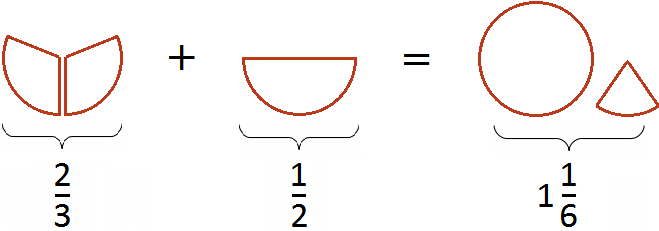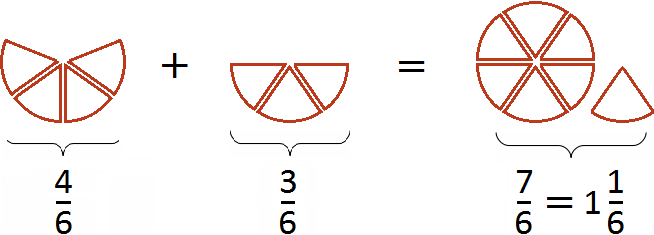Now let's learn how to add fractions with different denominators. When fractions are added, the denominators of those fractions should be the same. But they are not always the same.
For example, fractions ![]() and
and ![]() can be added together because they have the same denominators.
can be added together because they have the same denominators.
But fractions ![]() and
and ![]() cannot be added together at once because these fractions have different denominators. In such cases, fractions must be reduced to the same (common) denominator.
cannot be added together at once because these fractions have different denominators. In such cases, fractions must be reduced to the same (common) denominator.
There are several ways to reduce fractions to the same denominator. Today we will look at just one of them, since the others may seem complicated to a beginner.
The essence of this method is that first we look for the least common multiple (LCM) of the denominators of both fractions. Then the LCM is divided by the denominator of the first fraction and the first additional multiplier is obtained. Do the same with the second fraction - LCM divided by the denominator of the second fraction and get the second additional multiplier.
Then the numerators and denominators of the fractions are multiplied by their additional multipliers. As a result, fractions with different denominators are converted to fractions with the same denominators. And we already know how to add such fractions.
Example 1. Add fractions ![]() and
and ![]()
These fractions have different denominators, so you need to reduce them to the same (common) denominator.
First, find the least common multiple of the denominators of both fractions. The denominator of the first fraction is number 3, and the denominator of the second fraction is number 2. The least common multiple of these numbers is 6
LCM (2 and 3) = 6
Now back to fractions ![]() and
and ![]() . First, divide the LCM by the denominator of the first fraction and get the first additional multiplier. The LCM is 6, and the denominator of the first fraction is 3. Dividing 6 by 3, we get 2.
. First, divide the LCM by the denominator of the first fraction and get the first additional multiplier. The LCM is 6, and the denominator of the first fraction is 3. Dividing 6 by 3, we get 2.
The resulting number 2 is the first additional multiplier. Write it to the first fraction. To do this, make a small diagonal line above the fraction and write the additional multiplier found above it:
![]()
Do the same with the second fraction. We divide the LCM by the denominator of the second fraction and get the second additional factor. LCM is 6, and the denominator of the second fraction is 2. Dividing 6 by 2, we get 3.
The resulting number 3 is the second additional multiplier. Write it to the second fraction. Again make a small diagonal line over the second fraction and write the found additional multiplier over it:
![]()
Now we are all set for addition. It remains to multiply the numerators and denominators of the fractions by their additional multipliers:

Look carefully at what we have come to. We came to the fact that fractions with different denominators turned into fractions with the same denominators. And we already know how to add such fractions. Let's solve this example to the end:

This completes the example. Add ![]() to
to ![]() and you get
and you get ![]() .
.
Let's try to represent our solution with a picture. If you add ![]() pizza to
pizza to ![]() pizza, you get one whole pizza and one sixth of a pizza:
pizza, you get one whole pizza and one sixth of a pizza:

The reduction of the fraction to the same (common) denominator can also be shown. Bringing fractions ![]() and
and ![]() to a common denominator, we got fractions
to a common denominator, we got fractions ![]() and
and ![]() . The two fractions will be represented by the same pieces of pizza. The only difference will be that this time they will be divided into the same fractions (reduced to the same denominator).
. The two fractions will be represented by the same pieces of pizza. The only difference will be that this time they will be divided into the same fractions (reduced to the same denominator).

The first picture represents the fraction ![]() (four pieces of six), and the second picture represents the fraction
(four pieces of six), and the second picture represents the fraction ![]() (three pieces of six). Adding up these pieces we get
(three pieces of six). Adding up these pieces we get ![]() (seven pieces of six). This fraction is improper, so we highlighted the integer part of it. The result was
(seven pieces of six). This fraction is improper, so we highlighted the integer part of it. The result was ![]() (one whole pizza and another sixth of a pizza).
(one whole pizza and another sixth of a pizza).
Note that we have written this example in too much detail. In schools it is not customary to write in such a detailed way. You need to be able to quickly find the LCM of both denominators and additional multipliers to them, and quickly multiply the found additional multipliers by their numerators and denominators. If we were in school, we would have to write this example as follows:

But there is also the other side of the coin. If you don't take detailed notes during the first stages of learning math, you start to get questions like "where did that number over there come from?", "why do fractions suddenly turn into completely different fractions?"
Therefore, at the first stages, it is advisable to write down every detail. You can brag only in the future, when the basics have been mastered.
To make it easier to add fractions with different denominators, you can use the following step-by-step instructions:
- Find the LCM of the denominators of fractions;
- Divide the LCM by the denominator of each fraction and obtain an additional multiplier for each fraction;
- Multiply the numerators and denominators of fractions by their additional multipliers;
- Add fractions that have the same denominators;
- If the answer is an improper fraction, select the integer part of it;
Example 2. Find the value of the expression  .
.
Let's use the instructions above.
Step 1. Find the LCM of the denominators of fractions
Find the LCM of the denominators of both fractions. The denominators of the fractions are numbers 2, 3, and 4.

![]()
Step 2: Divide the LCM by the denominator of each fraction and obtain an additional multiplier for each fraction
Divide the LCM by the denominator of the first fraction. LCM is 12, and the denominator of the first fraction is 2. Divide 12 by 2 to get 6. We get the first additional factor 6. Write it over the first fraction:
![]()
Now divide the LCM by the denominator of the second fraction. LCM is 12, and the denominator of the second fraction is 3. We divide 12 by 3 and get 4. We have a second additional factor 4. Write it over the second fraction:
![]()
Now divide the LCM by the denominator of the third fraction. LCM is 12, and the denominator of the third fraction is 4. We divide 12 by 4 and get 3. We have a third additional factor of 3. Write it over the third fraction:
![]()
Step 3: Multiply the numerators and denominators of fractions by their additional multipliers
Multiply the numerators and denominators by their additional multipliers:

Step 4: Add fractions with the same denominators
We found that fractions with different denominators turned into fractions with the same (common) denominators. It remains to add these fractions. We add them up:

The addition did not fit on one line, so we moved the remaining expression to the next line. This is allowed in mathematics. When an expression does not fit on one line, it is moved to the next line, and you must put an equal sign (=) at the end of the first line and at the beginning of the new line. The equality sign on the second line indicates that it is a continuation of the expression that was on the first line.
Step 5. If the answer is an Improper fraction, select the integer part of it
Our answer is an improper fraction. We must isolate the integer part of it. We do:

We got the answer ![]()


2. If you find an error or inaccuracy, please describe it.
3. Positive feedback is welcome.